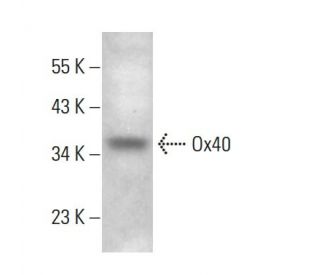

Ox40 Antibody (2Q1716): sc-71768
- Ox40 Antibody (2Q1716) is a rat monoclonal IgG1, cited in 1 publications, provided at 200 µg/ml
- raised against OX40 of mouse origin
- recommended for detection of Ox40 cell surface antigen of mouse, rat and human origin by WB, IP, IF and FCM
- available conjugated to either phycoerythrin or FITC for IF and FCM
- At present, we have not yet completed the identification of the preferred secondary detection reagent(s) for Ox40 Antibody (2Q1716). This work is in progress.
QUICK LINKS
Ox40 Antibody (2Q1716) is a rat monoclonal IgG1 antibody that detects the Ox40 cell surface antigen of mouse, rat, and human origin by western blotting (WB), immunoprecipitation (IP), immunofluorescence (IF), and flow cytometry (FCM). Ox40 (2Q1716) antibody is available in both conjugated and non-conjugated forms, providing flexibility for various experimental needs. Ox40, also known as CD134 or Ox40R, is a crucial member of the tumor necrosis factor receptor (TNFR) family, playing a significant role in the immune response. Ox40 is primarily located on the surface of activated CD4+ T lymphocytes, where Ox40 is essential for the coordination of T cell selection, migration, and cytokine differentiation, particularly in T helper (Th)1 and Th2 cells. The interaction between Ox40 and Ox40L, predominantly expressed on activated B cells, delivers a potent costimulatory signal that enhances T cell activation and promotes optimal CD4+ T cell responses both in vivo and in vitro. This signaling pathway regulates immune responses, influencing the development of T cell-dependent humoral responses and contributing to immune homeostasis. Members of the TNFR superfamily, including Ox40, are critically involved in regulating infections, inflammation, autoimmune diseases, and tissue homeostasis, underscoring Ox40′s importance in both health and disease.
Alexa Fluor® is a trademark of Molecular Probes Inc., OR., USA
LI-COR® and Odyssey® are registered trademarks of LI-COR Biosciences
Ox40 Antibody (2Q1716) References:
- Roles of OX40 in the pathogenesis and the control of diseases. | Hori, T. 2006. Int J Hematol. 83: 17-22. PMID: 16443547
- Targeting OX40 and OX40L for the treatment of autoimmunity and cancer. | Redmond, WL. and Weinberg, AD. 2007. Crit Rev Immunol. 27: 415-36. PMID: 18197805
- OX40-OX40 ligand interaction in T-cell-mediated immunity and immunopathology. | Ishii, N., et al. 2010. Adv Immunol. 105: 63-98. PMID: 20510730
- OX40/OX40 ligand interactions in T-cell regulation and asthma. | Kaur, D. and Brightling, C. 2012. Chest. 141: 494-499. PMID: 22315115
- OX40 promotes obesity-induced adipose inflammation and insulin resistance. | Liu, B., et al. 2017. Cell Mol Life Sci. 74: 3827-3840. PMID: 28612217
- The immunobiology of CD27 and OX40 and their potential as targets for cancer immunotherapy. | Buchan, SL., et al. 2018. Blood. 131: 39-48. PMID: 29118006
- OX40 expression in neutrophils promotes hepatic ischemia/reperfusion injury. | Jin, H., et al. 2019. JCI Insight. 4: PMID: 31672934
- OX40 as a novel target for the reversal of immune escape in colorectal cancer. | Yan, LH., et al. 2021. Am J Transl Res. 13: 923-934. PMID: 33841630
- OX40 agonism enhances PD-L1 checkpoint blockade by shifting the cytotoxic T cell differentiation spectrum. | van der Sluis, TC., et al. 2023. Cell Rep Med. 4: 100939. PMID: 36796366
- Challenges and opportunities in the development of combination immunotherapy with OX40 agonists. | Redmond, WL. 2023. Expert Opin Biol Ther. 23: 901-912. PMID: 37587644
Ordering Information
| Product Name | Catalog # | UNIT | Price | Qty | FAVORITES | |
Ox40 Antibody (2Q1716) | sc-71768 | 200 µg/ml | $316.00 | |||
Ox40 Antibody (2Q1716) FITC | sc-71768 FITC | 200 µg/ml | $330.00 | |||
Ox40 Antibody (2Q1716) PE | sc-71768 PE | 200 µg/ml | $343.00 |
